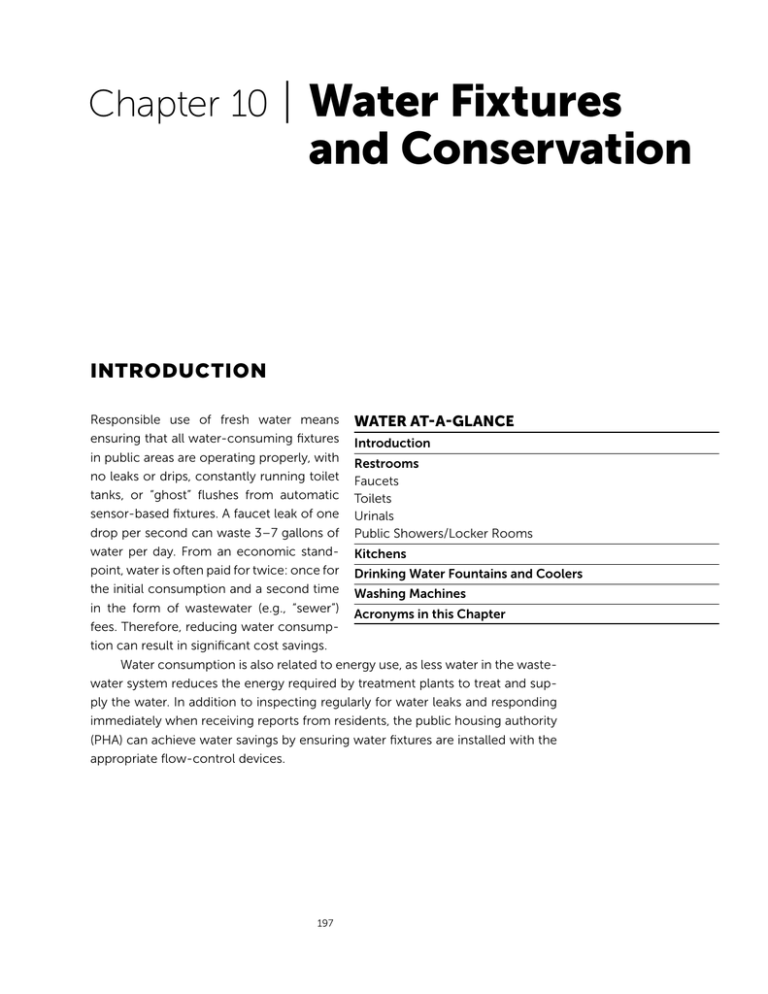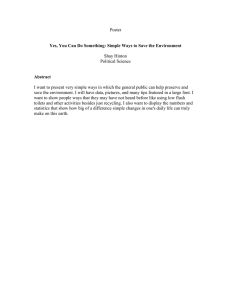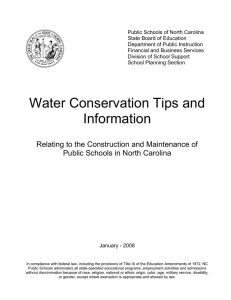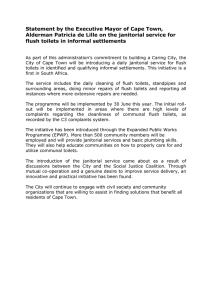Chapter 10 | Water Fixtures and Conservation
advertisement

Chapter 10 | Water Fixtures and Conservation Introduction Responsible use of fresh water means WATER AT-A-GLANCE ensuring that all water-consuming fixtures Introduction in public areas are operating properly, with Restrooms no leaks or drips, constantly running toilet Faucets tanks, or “ghost” flushes from automatic Toilets sensor-based fixtures. A faucet leak of one Urinals drop per second can waste 3–7 gallons of Public Showers/Locker Rooms water per day. From an economic stand- Kitchens point, water is often paid for twice: once for Drinking Water Fountains and Coolers the initial consumption and a second time Washing Machines in the form of wastewater (e.g., “sewer”) Acronyms in this Chapter fees. Therefore, reducing water consumption can result in significant cost savings. Water consumption is also related to energy use, as less water in the wastewater system reduces the energy required by treatment plants to treat and supply the water. In addition to inspecting regularly for water leaks and responding immediately when receiving reports from residents, the public housing authority (PHA) can achieve water savings by ensuring water fixtures are installed with the appropriate flow-control devices. 197 Restrooms Faucets Current green building plumbing codes1 require most public restroom faucets to have a flow rate of no more than 0.5 gallons per minute (gpm). Older restroom faucets may have flow rates of 2.2 gpm or higher, so significant water savings results from simply installing new faucet flow-control devices (aerators) with a 0.5 gpm flow rate. Replacement flow-control devices are available in two flow types: aerated stream or laminar flow. Aerators add air to the water and tend to feel “lighter” in flow. Laminar flow devices produce a stream comprised only of water; they feel “heavier” and may be perceived as a higher flow rate by users. Laminar flow controls also tend to deliver a constant flow rate of water regardless of any variance in the incoming water line pressure. Action Items Replacement flow-control devices can be an acceptable fix until faucets are replaced with 1. Ensure public faucets use faucet flow-control devices, such as aerators, that have a flow rate of no more than 0.5 gallons per water-efficient models. minute. If faucets are due for replacement, select 2. Ensure public toilets use no more than 1.6 gallons per flush (gpf). faucets with a flow rate of 0.5 gpm. When fauHigh-efficiency 1.28 gpf toilets and dual-flush (0.8–1.1 gpf/1.28– cet replacement is not possible, ensure that 1.6 gpf) toilets are available and may be acceptable replacethe pre-installed flow-control device (typically ments. 1.5 gpm–2.2 gpm for retail faucets) is replaced 3. Ensure public urinals have a flushometer with a maximum flow with the correct replacement 0.5 gpm model. rate of 0.5 gpf. Lower flow rates of 0.25 gpf (one-quarter gallon) The PHA should also consider faucets or 0.125 gpf (one pint) flushometers are also available and may with electronic sensors that turn faucets on be acceptable replacements. and off when hands are detected or mechani4. Inspect public drinking fountains regularly for leaks and proper cal metering devices that dispense a pre-set function. Fountains that chill water should have insulated piping. Install a timer to turn off refrigeration during periods of low use, amount of water. Electronic sensor faucet and adjust the dispensed water temperature to 70° Fahrenheit models are available that may be hardwired, (versus the typical 50–65°F). controlled with a battery pack (that must be 5. Check washing machines weekly for water leaks, and investigate periodically replaced), or even use a built-in resident comments about malfunctioning equipment. solar panel or internal hydroelectric turbine to recharge the battery during use. Toilets Toilets in public restrooms may be either flushometer or tank style. Flushometer toilets use water directly from the building water supply to flush automatically International Green Construction Code, March 2010. 1 198 Green Building Operations and Maintenance Manual after each use and may be manually (via lever or button) or sensor-operated. Tank-style toilets store the water needed for flushing in a tank that must be refilled after each use. Tank-style toilets may be gravity fed or contain a pressureassistive device in the tank to increase the force of the water during flushing. If a toilet has a pressure-assist device, it is important that the pressure is set correctly. If the pressure is too low, it will not flush correctly, but if the pressure is too high, the pressure valve may rupture. Pressure-assist tank-style toilets can be somewhat noisier due to the “whoosh” from the air pressure when flushed or air compression when refilling, but in public areas, the slight additional noise may not be an issue. Pre-1992 toilets may have a flow rate of up to 7 gallons per flush (gpf). Given the longevity of vitreous china and availability of replacement parts for the tank mechanisms, many of these older toilets are still in use. While retrofit devices and techniques exist to reduce the flow rate of older tank-style toilets, often design issues impair the function with a reduced flow of water and do not result in water savings (e.g., from double flushing). Achieving both performance and water savings usually requires replacing older tank-style toilets with new ones. Replacement flushometers are available to retrofit older flush valves to meet or exceed current water conservation flow rates. Current plumbing codes require a maximum flow rate of 1.6 gpf, and some high-efficiency models that are part of the EPA’s WaterSense program use only 1.28 gpf. Dual-flush tank-style toilets are also available that use a half flush (typically 0.8 gpf) for liquid waste and full flush (1.6 gpf) for solid waste. Dual-flush flushometers are also available with a 1.6 gpf full flush or 1.1 gpf reduced water flush. There is a minor educational component to using dual-flush toilets, as users must select the proper button or lever direction, and thus may be more suited to public restrooms used by a consistent group of users (e.g., staff or residents) versus those used by the general public. Urinals As with toilets, pre-1992 urinals can use up to 5 gallons per flush. Due to their fairly durable and wall-mounted design, some are still in use. Current plumbing codes require a maximum flow rate of 0.5 gpf and WaterSense compliance, but replacement flushometers are available that use 0.25 gpf (one-quarter gallon) or 0.125 gpf (one pint). It is important to consult the manufacturer of the replacement flushometer to ensure compatibility with the actual vitreous china urinal fixture. Another option is a waterless urinal, designed to function without the need for a water flush after use. Most models require a sealing liquid or cartridge to maintain the trap seal that must be periodically replaced, although some newer models use only mechanical action. These fixtures require somewhat different water fixtures and conservation 199 cleaning and maintenance procedures, so the cost of the new fixture and any additional maintenance items (e.g., trap seal cartridges) or procedures should be considered along with the water savings. Public Showers/Locker Rooms If there are public showers for staff or locker room areas, the PHA should check to see if the showerhead is functioning properly and if there are leaks or drips from fixtures, particularly if the facilities are used infrequently. If possible, replace older fixtures with water-efficient fixtures, typically 1.7-2.5 gpm. There are 1.5 gpm showerheads available, but as the gpm decreases, the pressure increases and the combination of hot water and pressure may risk scalding. All fixtures should be checked (such as a dripping faucet), as a small leak can result in a large amount of water consumed. Kitchens If there is a common kitchen area, check faucets to ensure the fixtures are functioning properly and there are no drips or leaks. If aerators are installed, check that they are functioning properly and at the appropriate gallons per minute. (Typical residential aerator values are 1.5–2.0 gpm for kitchen.) If not installed, consider purchasing aerators as they can be effective ways to manage water use when installed properly. Residents may remove aerators if the flow rate is too low, which would result in additional water use. The PHA may also consider a gooseneck-type faucet, which helps prolong the life of the fixture as there are less instances of residents pulling on the faucet neck while trying to wash large objects or fill large pots. If there are dishwashers in the common areas, refer to the WaterSense or ENERGY STARÒ requirements for current specifications since there are different specifications for commercial and residential dishwashers. (The current ENERGY STAR specification for residential dishwashers is no more than 0.88 cycles per kilowatt hour for a compact model and water consumption in the range of 0.54–1.0 gallon per rack of dishes for a commercial dishwasher.) The PHA should also check inlet water hoses and shut-off valves and ensure no water puddles around the equipment. Any loud noises or external water flow from dishwashers may be a sign that the equipment is malfunctioning. 200 Green Building Operations and Maintenance Manual Drinking Water Fountains and Electric Water Coolers If the PHA has water fountains in public areas, check them regularly. Water fountains tend to have fairly low flow rates (often 0.5–0.7 gpm) and operate only when a button or push bar is depressed. Regular inspection, such as with daily cleaning, will ensure that the bubbler head is not leaking water or that the buttons or push bars are not stuck in the “on” position. Electric water coolers that chill water prior to dispensing (via internal or remote refrigeration) have an additional opportunity to save energy. Any accessible piping can be insulated, a timer can be installed to shut off the refrigeration during periods of low use (e.g., late evening), and the dispensed water temperature can be adjusted to 70° Fahrenheit (versus the typical 50–65°F). Washing Machines Whether the PHA uses a commercial size washing machine or a “residential” model, regular inspections help avoid problems, especially water leaks that can be substantial (due to the flow rate of water in the inlet hoses and the low traffic of laundry rooms) or dangerous (due to the presence of electricity for washers and dryers). Investigate residents’ comments about machines “not working” or “washing strangely” promptly. Check washing machines for leaks at least bi-weekly, with attention paid to the inlet water hoses and shutoff valves. The owner’s manual for the particular model of washing machine (check online if the hard copy is missing) should provide any recommended maintenance activities, such as cleaning the inlet water filters and lint filter, to allow the washing machine to operate at maximum efficiency. When replacing equipment, purchase washing machines labeled as part of the ENERGY STAR program, or that exceed the program’s guidelines based on the yellow EnergyGuide label found on most appliances. Clothes washers that have earned this designation are 30% Acronyms in This Chapter more efficient than non-qualified models. water fixtures and conservation gpf Gallons per flush gpm Gallons per minute 201





